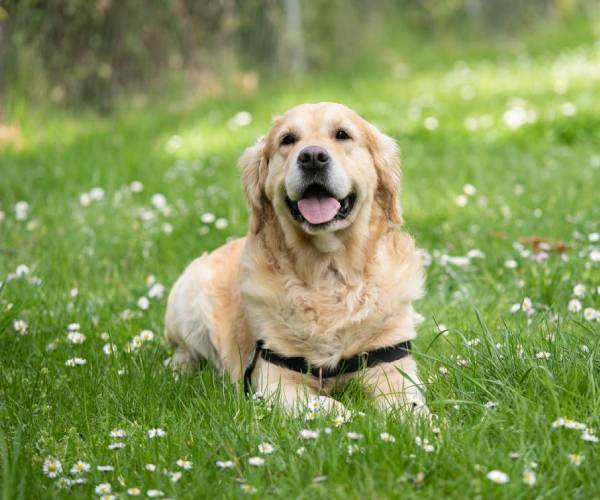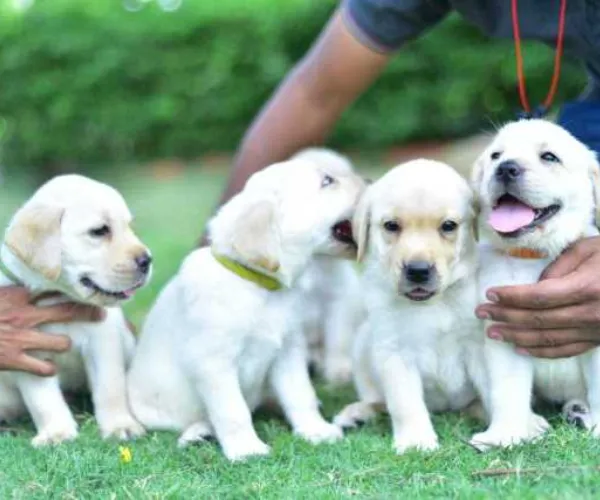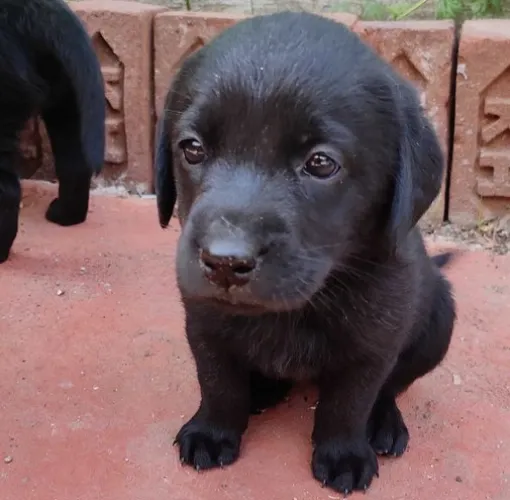Labrador Retriever Introduction
Forget the pompous aristocrats and delicate ladies. Look at the Labrador Retriever and a canine whirlwind of loyalty, joy, and insatiable passion. Imagine a bobbing ball of unending energy, an enthralling tail the size of a feather duster, eyes giddy with laughter, and a heart full of affection. This, my dear readers, can be the Lab in an easy-to-understand way.
However, the Lab is more than just a cutesy pie with much energy. It's also a graceful giant, an ally for tiny heels and shaky knees. He's a jolly companion in the midst, ready to go for muddy walks with slobbery kisses and thrilling games of play at the parks. He's a faithful confidante who offers a cozy arm to hold your shoulder and an oozy nose to wipe off your tears.
The Labrador's journey began in Newfoundland, where the dog gained his stripes as a fisherman's assistant, helping retrieve nets and bring in boats. However, this water-loving dog moved effortlessly from the rough shores to cozy fireplaces, becoming the ultimate pet for families. When chasing butterflies in the backyard or snuggling on the couch during movies, The Lab thrives with love and affection.
If you're looking for a dog that will fill your day with adventure, laughter, and unrelenting devotion, Look at the Lab. He's the dog who's always there to help you, the canine counselor who isn't judgmental, and the adventure companion who's up for anything, from a stroll to a muddy water puddle. He's the Lab and is waiting to play with your heart.
Are you willing to give your life to the delights of the joy of a Lab? Let's discover the wonders of this beautiful dog breed—one tail that wags and one kiss and one dirty paw print at a time.
| Origin |
Newfoundland, Canada |
| Breed Group |
Sporting |
| Size |
Males weig 65-80 pounds (29-36 kg) and females weigh 55-70 pounds (25-32 kg). |
| Lifespan |
10 to 14 years |
| Coat |
The hue of a Labrador Retriever's coat will be determined by genetics. According to the AKC breed standard, the most acceptable Labrador Retriever colors are brown, black, and yellow. However, certain breeders could create Labradors in different colors, including silver, white, or charcoal labs. The AKC doesn't recognize these colors. However, they can be healthy and well-bred dogs. |
| Temperament |
Outgoing, friendly, with a gentle disposition. They are called one of the most amiable breeds of dogs and can be very good with other dogs and children. |
| Exercise Needs: |
Labrador Retrievers are active dogs requiring regular physical exercise and mental stimulation. They love playing, swimming, fetching, and walking. |
| Training Needs: |
They are extremely capable of being trained and are highly intelligent, making them among the most sought-after options for working dogs. This includes search-and-rescue and therapy aid dogs. |
| Grooming |
A Labrador Retriever has generally low grooming requirements. Regular brushing and baths will maintain the health of their coats. |
| Health |
Although generally healthy, Labradors may be susceptible to specific genetic health problems like elbow and hip dysplasia and eye problems. Regular vet checks can decrease the risks. |
Labrador Retriever Dog Breed Information | Labrador Retriever Price in India
With their exuberant enthusiasm, cheerful dispositions, and unfailing loyalty, Labrador Retrievers have captured hearts worldwide. If you're considering welcoming an adorable Lab into the fold of your Indian household, you may wonder what this shining ray of sunshine will cost. Get ready, dog lovers, because the Labrador price is steep. India is an experience in and of itself!
Unleashing the Factors Affecting Cost:
- Lineage:
- Basis Grade Basic Grade: A lab puppy without fancy papers can cost around Rs30,000-Rs50,000. Think of wagging tails, infinite games of fetch, and pure Lab appeal without the show ring ambitions.
- KCI registered: Puppies with Kennel Club of India registered parents can bump prices a little and range from between Rs40,000 and the cost of Rs60,000. The pedigree guarantees adherence to breed-specific standards as well as verification of lineage.
- Show Qualitative: Prepare to invest between Rs50,000 and Rs70,000 to acquire champion-potential pups with a perfect lineage and the potential to shine in the show arena.
- Color: Although all Labs are adorable, black Labradors could be a bit more expensive than chocolate or yellow Labs.
- Place: Big cities like Delhi and Mumbai could be pricier when compared to smaller towns. Based on the city and other aspects, expect to pay between Rs25,000 and Rs70,000.
Beyond the Initial Fetch:
Remember that your price is only the beginning of the Lab adventure. Prepare for ongoing costs such as:
- Food of high quality: These energetic pups require adequate nutrition to fuel their energy levels and impact your monthly budget.
- Vet treatment: Regular checkups, vaccinations, and possible health problems could add.
- Education: Labs are intelligent but require education to channel their unending energy and passion.
Before You Welcome Your Furry Retriever:
- Study your breed. Learn about their personality, fitness needs, temperament, and any health issues they may have before making a choice.
- Select a responsible breeder. Do your homework, Ask questions, and visit the kennel for the highest standards of breeding and healthy puppies.
- Be ready to be committed: Labs are active dogs that require regular exercise, training, and care. You must ensure that you give them everything they need to be successful.
Final Thoughts:
Although labs may come at a cost, their pleasure is unimaginable. Be wise, budget your money, and prepare to let your home and heart to the endless joy of unending affection, fun, and never-ending tail-wags. The bright smiles and infinite energy will make each penny worth it.
Extra Tip: Pay attention to unusually high prices. These could be a sign of compromised breeding practices or possible health problems. Consider investing in your next pet by selecting a reliable and ethical breeder.
Are you willing to be part of this Lab pack? Be aware that it's not simply a cost - it's a lifetime of unwavering dedication, incessant games of fetch, and a lifelong commitment to enjoying life thoroughly when you have the canine friend of your dreams. Prepare to unleash your inner adventurer since every day with the help of a Lab retriever is an adventure in the paws!
Labrador Retriever Physical Appearance
A Labrador Retriever, a canine canvas splattered with sunshine happiness, has an appearance that is as varied in his persona. Under the bright coats and playful eyes is an enduring structure designed to provide adventure and love.
The Sturdy Stature: Imagine an oval-shaped outline encased by a muscular frame hinting at athleticism but does not add bulk. Labs measure between 21.5 and 24.5 inches tall at the shoulder, with a weight range ranging from 55 to 80 pounds. They're small; however, their presence within an area is unquestionable.
A Coat of Sunshine: Three vibrant shades are featured in the Lab: The classic, joyful yellow, the rich chocolate brown, and sophisticated, elegant black. The three variations share the same short, thick double coat that is weatherproof and extremely easy to care for. You can brush it every week to keep sheds at bay and have another cuddle session to enjoy the softness.
A Head Full of Heart: Their broad head symbolises wisdom and love. The soft, expressive eyes, typically brown or hazel, shimmer with mischief and then melt into pools of affection. The floppy ears frame the beautiful face and add some whimsy with each head turn.
The Tail That Tells the Story: The Lab's Tail is a masterwork of motion, constantly moving as a furry, squeaky metronome set at "joy." This otter-like limb is a swarm of joy and propels them forward, exuding an inexhaustible supply of positive vibes.
Beyond the basics: The Lab's beauty is more than physical characteristics. It's the way that their eyes wrinkle as they smile. Their goofy smile breaks their faces before playing a game of fetch or the soft pet that sits on your lap, providing a quiet peace. This expression is powerful: fun with a sense of loyalty, dependability, and an irresistible passion for life.
Imagine an art piece painted with sunshine, happiness, love, and endless energy. This is the Lab, an active, breathtaking work of art ready to bring colour and lots of love into your life. Let your heart be open to this delightful masterpiece, and prepare to be amazed by the irresistible appeal of this adorable Labrador Retriever.
Labrador Retriever Personality
The Labrador Retriever's character isn't just a defining characteristic but an elemental force. Imagine a dazzling kaleidoscope of enthusiasm, love, and unending enthusiasm, blending to create a dog unlike any other. Others explore the Lab's soul and heart and uncover why they are so beloved.
A Playground with Paw Prints: The Lab's spirit is filled with fun energy. From the time they get up with a symphony that wiggles their tails to their final zoomie run around the house before it's time to go to bed, they're ready to have fun. Fetch, frisbee and playtime in the backyard are their favourite songs, sung with a joyful bark and dirt-splattered footprints. Prepare for unexpected games of tug-of-war with your socks or for impromptu cuddles that may make you kisses of slobber.
Loyalty is woven in their genes: for a Lab, it's not only a phrase; It's a principle. They deeply bond with their families, providing unfailing love and constant fuzzy comfort. If you're struggling with a difficult day or celebrating a victory, Their gentle gazes and playful gestures are a powerful message. They're the cheerleaders that celebrate your successes and are the silent guardians who help you overcome your fears.
Intelligent with a smile: Don't be fooled by their wacky smiles - Labs are smart cookies. They're willing to be loved, quick to learn and highly skilled at problem-solving (especially when surrounded by treats). From mastering tricks for obedience to finding out what to do with the door of your pantry (you might need to consider installing child-proof locks! ), Their intellect shines through in surprising ways.
Gentle Giants with Soft Spots: Beneath their exuberant bravado lies an inner deep gold heart. Labs are highly delicate, particularly with youngsters. Their protection instincts come on automatically, making them ideal children's playmates. They're often found among napping toddlers or sharing games with their pets (or not-so-furry) companions.
A Swirl of Sunshine on Even the most gloomy days: The Lab's optimism is infectious. Their unbridled happiness can be described as a bright ray of sunshine that shines through even the most gloomy clouds. Whatever life throws at you, their smile and joyful spirit can tell you that happiness is discovered in the most essential things, like a stroll in the park, playing in the backyard, or cuddling up on the sofa with your pet.
The Lab's character isn't just an assortment of characteristics; it's an actual, living representation of love, joy, and love. They're the partners in criminality, the furry therapists, the adventure companions and the cheerleaders who are always willing to offer you the highest acclaim, including wet noses and dirt-splattered footprints. Open your heart to the Lab's bright guide, and prepare to be taken away by an ebb and flow of laughter, adventures, and unwavering affection. Remember that life with Labs Lab is always exciting and always awe-inspiring.
Labrador Retriever Temperament
The temperament of the Labrador Retriever is more than just a tune; it's an entire orchestra of sweetness, grit, and sun. Like any good orchestra, various styles and subtle variations create a portrait of the loved breed. Explore the nuances and temperament and discover what makes them wonderful canine companions.
Allegro Con Brio: The first movement is an allegro con Brio, an ebb and flow that shows the Lab's unstoppable enthusiasm and energy. They're incredibly playful and affectionate, always ready to take on games of play, a walk through the parks, or a spontaneous cuddle session. The playful spirit doesn't just apply to puppies. Even adult Labs keep a youthful enthusiasm for life that's irresistible.
Andante Moderato, However, the Lab's temperament isn't only about high-octane excitement. There's also an Andante Moderato movement, a soft sway of loyalty and devotion. They are deeply connected to their families and offer an unwavering support system and a constant source of comfort for their furry friends. When you're celebrating your victory or battling a setback, their soft eyes and calming presence can make things feel comfortable.
Presto Agitato This time, you can throw the ball into presto agitato. This is a fun play that can result in muddy footprints on the floor and even socks that have been stolen turned into chewing toys. Labs are curious animals, and their enthusiasm can sometimes take over them. However, even their naughty behaviour comes with cute puppy eyes and sweet tails that wag, making it difficult to resist their adoration.
Largo Maestoso: When children are involved, their temperaments take the form of a maestoso in a largo with a majestic calmness, which makes them ideal friends. The protective instincts of Labs come on and create a secure and safe space for the little youngsters to play and develop. It is expected to see them playing with toys, giving gentle nudges, or protecting themselves with big fingers and kisses that slobber.
Pianissimo There's the pianissimo motion with a serene awareness evident in their eyes, which are full of soul. Labs are compassionate creatures that can sense your feelings and provide gentle comfort whenever needed. When you're down or anxious, a Lab's peaceful presence can be soothing, reminding you that you're not alone.
Its personality is a masterpiece with a seamless combination of fun, loyalty, intelligence, and compassion. They're the joyful music lovers who fill your days full of laughter: kind giants who provide unwavering support and the lovable psychotherapists who don't judge. Therefore, let your heart open to the musicality of the Lab and be prepared to be swept off by a musical symphony of joy, love and unwavering dedication. Be aware that the life of the Lab is never dull and is a beautiful orchestration.
Labrador Retriever Grooming Needs
Ah, the Labrador Retriever. The furry bundles of happiness with endless energy and minimal grooming needs! These adorable goofballs may shed like champions, dropping fur-covered twigs all over your floor. However, their thin coats, which are weatherproof, require low maintenance. Let's explore this universe of Lab grooming, where simple prevails and sheds don't have to be a sexy experience.
Brush up on your brushing: While their short coat could appear like a dream that can be fulfilled, regular brushing is essential to preventing shed and keeping their coats healthy. A quick brushing every week or once using a medium-bristled or rubber mitt removes the hair from the floor and ensures no matting. When the shedding season is at its peak (hello, springtime, autumn and the season of the year! ), increase the frequency of your brushing to prevent fur snowstorms from your living space.
Bath Time without the Drama Contrary to some breeds that are high maintenance, Labs don't need frequent baths. Bathing too often can remove their coats of natural oils and cause drying or irritation. Try to clean them every 6-8 weeks. You can go further frequently when they've been in a particularly smelparticularlyon (mud Puddles any,ne?). Use an easy dog shampoo, and remember to add conditioner, which will keep your coats smooth and shiny.
Nail Trimming to Make Happier Paws: Clickety-clacks on the hardwood flooring? I need a nail trim! Regularly trimming your nails is crucial to ensure your health and well-being. Long nails can cause discomfort for Labs and could cause injuries. Buy a pair of nail clippers for dogs and get yourself with the snap (the pink part of the nail). If you need more clarification, consult your vet for a quick demonstration.
Ear Care for Sound-related Reasons: Floppy ears are cute but hold dirt and moisture and create the ideal place for infection breeding. Examine their ears frequently for signs of redness, discharge or unpleasant smells. Clean them gently with an ear wipe for dogs every week to avoid the build-up.
Dental Delight Cleaning your white pearls in good condition is crucial for Lab health. Brush their teeth at least weekly with a specific dog toothpaste and toothbrush. Dental chews are also a great way to keep tartar and plaque at the bare minimum.
Beyond the basics: Remember that grooming should be more than appearances. It's a time of bonding, a chance to examine for bumps or lumps, and me. It depends on your dog's overall health. It should be a fun event with plenty of treats and praise, and your pet will surely enjoy their pampering just like you would.
Therefore, you should embrace the shed (invest in a quality lint roller! ), schedule occasional baths, and ensure you groom those nails. This will ensure that the Labrador Retriever's grooming requirements are minimal, allowing you plenty of time to do fun things like strolls in parks and games of fetch or endless cuddling with your furry pet. Remember that a happy Lab is a tidy Lab (ish), and a clean Lab will always be ready to go on a new adventure!
Labrador Retriever Exercise Needs
The Labrador Retriever is a canine full of enthusiasm and joy that needs more than cuddling on the couch to thrive. They are designed to be active, with unending energy begging to let loose. So, get your sneakers and the door and get ready to plunge into the enthralling realm of Lab's fitness demands!
A Daily Dash: Imagine the furry rocket powered by the sun and the tail that wags. This is your Lab, and they should get at least two hours of vigorous training daily to stay healthy and happy. This is more than just a stroll through the neighbourhood. We're talking about brisk walks, jogging, hiking, swimming lessons or anything else that makes their heartbeat and their feet pound on the ground.
Beyond the walk: While walks are lovely, there is a variety that is the flavour of life in a lab! Think agility courses, Frisbee, frisbee races, fetch marathons or even games of nosework. Labs thrive off mental stimulation in addition to physical activity, So keep their minds engaged with exciting new games and challenges.
Water Warriors: Do you remember the Newfoundland roots? Labs are the natural water babies! If you've got access to a river, lake or even a child pool, let them unleash their otter instinct as they splash around with excitement. Make sure you're ready for a soaking when you're finished!
Indoor Adventures: Rain or shine, the adventure has to continue! A rainy day doesn't need to make them feel down. Indoor fetch with a lively ball, tug-of-war games with a sturdy rope, or even hide-and-seek can keep them active and entertained.
The Puppy Pace Yourself Keep in mind that puppies are still developing. They begin with shorter workouts and gradually increase their duration and intensities as they age. Excessive exertion in a young Lab can cause injuries, so make sure you are aware of their body and stop when they need to.
The importance of balance: Exercise isn't just about burning calories and mental well-being. Regular exercise can prevent destructive behaviour, boredom and anxiety. An exhausted Lab is a content Lab and is ready to curl up on your couch at the end of the day.
"Listen to You" Lab: They'll communicate their desires through body language. A smile and excited eyes signal, "Let's go! "Panting and drooping ears could indicate "Time for a break." Please take note of their signs and adjust your activity level according to the signals.
Fueling the fun: All that exercise requires adequate fuel! Feed your Lab an excellent diet designed for active dogs. This will provide them with the energy needed to maintain their busy life.
More than just exercise: Exercise is only one part of the piece. Add passion, training, motivation, and mental stimulation to make an overall Lab that is healthy, happy and ready to tackle the world.
So, eliminate that couch potato habit and unleash the adventure within your Lab. Take advantage of the runs, walks, the water, and messy play fetch games. Remember that a happy Lab is a tired Lab, and an exhausted Lab is the ideal cuddle partner. Get your leash and enthusiasm for adventure, and get ready to be swept away by the rush full of confidence that's The Labrador Retriever!
Labrador Retriever Training Needs
Ah, The Labrador Retriever - a whirlwind of sun, slobbery kisses and endless energy. But behind that cute exterior lies a soul keen to learn and a heart wanting to be loved. Training is the key to achieving this, transforming playful dogs into friendly companions and allowing them to reach their full potential. Take your food and patience, and get ready to dive into the world of training in a Lab!
Early Intervention is the Key:
- Be sure to begin training before your puppy is an adorable hurricane.
- Start by teaching basic commands like "sit," "stay," and "come" during puppyhood, with positive reinforcement and lots of praise.
- Remember that Labs love to please, so make training enjoyable and rewarding instead of something to do.
Congruity is your Guide: Labs thrive on consistent and precise expectations. Establish consistent limits and regulations and adhere to unwavering determination and fairness. A disorganized lab is unstable, and you must provide the constant guidance they require.
Engage Their Passion: Don't let their unlimited energy become a learning challenge. Make it a positive outlet, such as agility courses, obedience contests, or nosework games. Physical activity and mental stimulation are the key to successful training.
Keep it positive always: Ditch the harsh instructions and techniques for punishment. Labs are most responsive to positive reinforcement. Give them praise, treats and affection for their desired behaviour and tell them you value it.
Socialization is a Superpower. Get your Lab to different people, places and experiences at the age of a puppy. This will allow them to become well-adjusted and confident dogs that do not shy away from new situations. Remember, a social Lab is a content Lab and is ready to welcome all the people around them with a happy tail.
Be patient: Training takes time, particularly with fun Labs. Do not be discouraged by occasional hiccups. Rejoice in the small wins, persevere with their growth, and remember that consistent positive reinforcement is essential to unlocking their potential.
Beyond the basics: Do not limit your training to simply remaining in a classroom. Labs are intelligent animals that can master complex techniques and commands and even engage in therapeutic work. Always keep them challenged and enjoyable, and observe the amazing things they can accomplish with your help.
Create a bonding experience: It's not just about obeying commands. Make it an enjoyable bonding experience, a shared experience where you can learn and develop together. Enjoy the laughs, fun times, and overwhelming sense of fulfilment when you teach your pet dog new things.
Learn Yourself To:
- Remember, training begins with you.
- Make yourself the calm, confident instructor of your Lab requires.
- Study positive reinforcement strategies, be patient, learn to practice, and have fun!
Therefore, let that inner coach pull out your clicker and prepare to embark on a voyage of discovery, laughter, and undying affection for Your Labrador Retriever. Training isn't only about commanding; it's about forming an enduring bond, encouraging trust and respect, and building a healthy and balanced companion who brings joy to your life and never-ending tail-waving. Enjoy your training!
Labrador Retriever Health Concerns
Ah, The Labrador Retriever - a whirlwind of happiness, loyalty and unending energy. The adorable poodles fill our lives with sun and slobbery kisses. However, like any breed, they're immune to the health risks. Therefore, let's shed illumination on the dark side by examining the problems Labradors face and how to ensure they remain happy and healthy into their golden years.
Joint Problems: Hip and elbow dysplasia, which causes joints to become abnormal, are frequent in Labs. The symptoms include stiffness, limping in the upper part of the body, difficulty getting up, and reduced activities. The early detection of the problem and prompt veterinary treatment are essential to ease the joint pain and prevent further injury. Good breeding practices focusing on healthy joints and elbows are crucial to reducing the risk.
The Bloat Boogie: This dangerous stomach condition, in which the stomach turns and blocks the blood supply, demands urgent veterinary attention. Signs include abdominal pain that is fast, as well as excessive drooling and difficulty breathing. Being aware of the symptoms and prepared could save your Lab's life.
Eye on the Prize: Labradors can be susceptible to various eye diseases, such as progressive retinal atrophy (gradual vision loss) and cataracts (lens clouding). Regular eye examinations by your veterinarian are crucial for detecting and treating the condition early.
Weighty Matters Labs enjoy eating and are overweight, which can be problematic if it's not dealt with. Being overweight can strain their joints, heart, and overall health. Being healthy and maintaining a healthy weight with regular exercise and a healthy diet is essential to avoid obesity-related problems.
Ear Eruptions The ear canals of a floppy person can collect dirt and moisture, creating the ideal environment for infections. Regularly cleansing and looking for redness, discharge, or unpleasant odours is crucial to maintaining your ears' excellent health.
Cancer Concerns Similar to the other dogs, Labs are susceptible to different forms of cancer, including Hemangiosarcoma (a blood vessel cancer) and lymphoma. Regular visits to your vet can aid in detecting cancer early, which increases the likelihood of a successful treatment.
Responsible Ownership Important: The best way to ensure the health of your Lab is to take responsible ownership. Please give them a balanced diet, exercise routine, preventive health care via vaccines, vet checks, and parasite prevention. Early detection and treatment for any health problems is crucial to their health.
Prevention is more effective than Cure. Remember to value the effectiveness of preventative actions. Selecting a responsible breeder who is a proponent of tests for health and genetics will significantly lower the risk of inheritable diseases.
Enjoy the sunshine and get out of the shadows: As we've discussed possible health risks, Let's remember the happiness Labradors bring. With love, caring management, and proactive steps, you will assist your Lab in living a long, healthy existence.
Be aware that labs aren't just pets; they're family members. By understanding their health risks and taking the necessary actions, you can be sure of an exciting future full of tail wags, sweet kisses, and endless adventures.
Labrador Retriever Fun Facts
Labradors aren't just fun dogs and faithful companions. They're alive, breathing fun facts factories! Prepare to enter the bizarre, fascinating and wonderful world of these delightful dogs:
Aquatic athletes: Remember landlubbers, Labs were born water babies! They're powered by their webbed foot, making them furry submarines and their waterproof coats ensure they stay warm in the icy deeps. They're natural retriever retrievers, effortlessly taking everything, like tennis balls or boots, lost out of the water.
Colourful Chameleons They are best known for their sunny yellow coats. However, Labs are available in three distinct colours! Chocolate Labs melt hearts with their cocoa-coloured fur, and black Labs radiate sleek sophistication. Whatever colour they choose, their hearts beat in the same way, with unending love.
The Name Game Do you realize that Labs aren't named for Labrador, Canada? The playful dogs came from Newfoundland and were able to help fishermen haul nets and pull on boats. Multitasking is a thing of the past!
Silent Heroes The Labs don't only look like cute fluffy balls; they're also trained heroes! They are guide dogs, search and rescue dogs, or even therapy dogs that bring happiness and comfort to those in need.
Scent Sensations: Their noses aren't a joke! Labs contain 220 million olfactory sensory receptors instead of just 5 million humans. This ability to smell makes them excellent sniffer dogs that can detect anything from explosives to drugs.
Tail Tales: That ever-wagging tail isn't just a cute thing. It's a way to communicate! A slow wag means they're content, a rapid wag shows excitement, and a tucked-between-the-legs wag indicates fear or anxiety. Find out the language of tails to know your furry friends.
Memory Marvels: Forget the goldfish brains. Labs are pretty intelligent! They can remember hundreds of commands and excel in agility and obedience training. Expect them to prepare your taxes less...
Cuddle champions: Don't be fooled by their vivacious exterior. Labs are cuddle lovers at heart. They are devoted to everything beyond a nice cuddle on the couch, giving you slobbery kisses and cuddles.
Forever Puppies: These playful puppies keep their playful spirit throughout their adulthood. They'll still run around like balls that bounce, play fun tug-of-war games, and bring a lot of laughter to your home.
And there you have it! Labrador Retrievers aren't just adorable faces. They're a bundle of love, fun and unexpected delights. Enjoy their quirky personalities, revel in the talents of these dogs, and get ready for an endless series of tail-wagging fun with these adorable furry companions.
Is Labrador Retriever Dog Breed right for You?
If you think the Labrador Retriever (Lab) is the best dog breed for you, it will depend on many aspects, such as your personality, lifestyle, and environment. This article will provide a summary of the advantages and disadvantages to help you choose:
Pros:
- Loyal and caring: Labs are known for their devotion to and affection for their family members. They are fond of cuddles, playing, and being with their family members.
- Fun and lively: Labs are full of energy and passion for living. They'll keep you entertained through games, walks and even adventures.
- Trainable and intelligent: Labs are innovative canines who are eager to please. This makes it relatively easy to train through positive reinforcement. This makes them ideal for first-time pet owners.
- Children are well-behaved: Labs are gentle and gentle with children, making them excellent family members. But, supervision is required because of their size and enthusiasm.
- Adaptable: Labs can adjust to different living environments, from rural to apartment houses, so long as they are given enough exercise and care.
- Multi-purpose: Labs excel in tasks such as retrieving the information, tracking or therapy. Their ability to think critically and desire to please makes it ideal for them to train in various roles.
- Low maintenance: Labs have thin, shed-proof coats requiring minimal grooming. But it is suggested to reduce shed.
Cons:
- Highly active: Labs require significant amounts of exercise each day (at minimum 2 hours! ), which makes them ineligible for people who are couch potatoes or who have limited mobility.
- Could be noisy: Labs love to bark, particularly when bored or exuberant. This is a problem for those living near each other or with restricted noise.
- Mouthy Labs tend to be known for their mouths, mainly when they are puppies. It can be a result of nipping, chewing and excessive biting. Rewarding and training consistently is essential.
- Possibility of drooling Labs do drool, but certain types are more significant than others. This may only be suitable for some, particularly those with furniture or possessions they'd like to keep.
- Instinctual predation: Labs have solid retrieving instincts and may even chase smaller animals such as cats or squirrels. Proper training and socialization are vital to curb this behaviour.
- Separation anxiety Labs are susceptible to separation anxiety if they are left in a secluded area for too long. This can result in destructive behaviours like chewing, barking, or pacing.
Things to think about:
- Your lifestyle: Are you active, and can you offer the physical activity the Lab demands?
- Your current living conditions: Do you have enough space to accommodate a large pet? Do you have the capacity for shedding and barking?
- Your experience: Are you a first-time dog owner? Labs can be an excellent choice for those new to the world. However, their energy and enthusiasm require dedication and consistent training.
- Your family members: Have you got children? Or other pets? Labs can do well with both, but appropriate introductions and supervision are essential.
Please find out more about breeders, talk to them and talk with Lab owners before making a choice. Consider adopting an adult Lab from an animal shelter if you're seeking a calmer dog or want to offer an animal that is homeless the opportunity to have a loving home.
Ultimately, deciding whether the Labrador Retriever would be the best pet for you is a personal decision. Be sure to weigh all the benefits and drawbacks with care and ensure you can provide the affection, love and exercise this beautiful breed requires to flourish.
















































































































